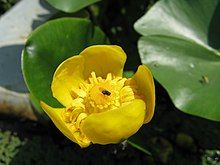Nuphar pumila
| Nuphar pumila | |
|---|---|

| |
| Scientific classification | |
| Kingdom: | Plantae |
| Clade: | Tracheophytes |
| Clade: | Angiosperms |
| Order: | Nymphaeales |
| Family: | Nymphaeaceae |
| Genus: | Nuphar |
| Section: | Nuphar sect. Nuphar |
| Species: | N. pumila
|
| Binomial name | |
| Nuphar pumila | |
| Subspecies[2] | |
| |
| Synonyms | |
|
Synonyms of Nuphar pumila subsp. pumila:[2]
Synonyms of Nuphar pumila subsp. sinensis:[3]
| |
Nuphar pumila, the least water-lily[4] or small yellow pond-lily, is an aquatic perennial plant in the Nymphaeaceae family. It is also known as the dwarf water lily since it looks like a smaller Nuphar lutea. while Nuphar pumila has a star-shaped, or lobed form of the stigma disc and glabrous leaf undersides, Nuphar lutea has a round stigma disc and the undersides of its leaves are occasionally fine-haired on the midribs. Its flowers bloom from July to August and are typically pollinated by flies.
The plant is more successful in sunny environments, predominantly in lakes, ponds and slow-flowing parts of rivers from Northern and Central Europe to Northern Asia, with a few noted habitats in North America; Nuphar pumila is considered endangered in France, Switzerland and the United Kingdom.
Description
[edit]Nuphar pumila flowers typically have 4–6 petals, are actinomorphic, have many stamen and range from yellow to green depending on maturity. Its floating leaves are large and ovate, with pinnate venation, while the submerged leaves are smaller and round; the plant also has a thick creeping rhizome.[citation needed]
Cytology
[edit]The chloroplast genome is 160737 bp long.[5]
Distribution
[edit]Nuphar pumila can be found in western Mongolia, Austria, Switzerland, Czech Republic, Germany, Spain, Denmark, Finland, Lithuania, Latvia, Norway, Poland, Sweden, UK and France.
Nuphar pumila can also be found in the United States (at least Michigan's upper peninsula).[6]
Taxonomy
[edit]Publication
[edit]It was first published as the variety Nymphaea lutea var. pumila Timm by Joachim Christian Timm in 1795. Later, it was elevated to the status of the separate species Nuphar pumila (Timm) DC. published by Augustin Pyramus de Candolle in 1821.[2]
Common names
[edit]Nuphar pumila is also known as Bwlyts Lleiaf in Welsh, Konnanulpukka in Finnish, Kleine Teichrose in German, "Бяцхан сахуу цэцэг" in Mongolian and Stulík malý in Czech.[7][8]
Uses
[edit]The root can be consumed to help alleviate digestive problems or serve as a tonic.[citation needed]
References
[edit]- ^ Maiz-Tome, L. 2016. Nuphar pumila. The IUCN Red List of Threatened Species 2016: e.T167888A1179645. https://dx.doi.org/10.2305/IUCN.UK.2016-1.RLTS.T167888A1179645.en. Accessed on 07 June 2022.
- ^ a b c "Nuphar pumila (Timm) DC". Plants of the World Online. Royal Botanic Gardens, Kew. Retrieved 29 January 2024.
- ^ "Nuphar pumila subsp. sinensis (Hand.-Mazz.) Padgett". Plants of the World Online. Royal Botanic Gardens, Kew. Retrieved 29 January 2024.
- ^ BSBI List 2007 (xls). Botanical Society of Britain and Ireland. Archived from the original (xls) on 26 June 2015. Retrieved 17 October 2014.
- ^ He, D., Gichira, A. W., Li, Z., Nzei, J. M., Guo, Y., Wang, Q., & Chen, J. (2018). Resolution of Intergeneric Relationships within the Early-Diverging Angiosperm Family Nymphaeaceae Based on Chloroplast Phylogenomics.
- ^ "Nuphar pumila (Small yellow pond lily)". Rare Species Explorer. Michigan Natural Features Inventory. Archived from the original on 28 September 2012. Retrieved 22 May 2012.
- ^ "Nuphar pumila" (PDF). Plantlives.com. Retrieved 17 August 2013.
- ^ "Least Water-lily". LuontoPortti/NatureGate. Retrieved 17 August 2013.

